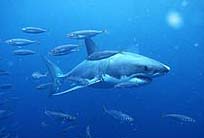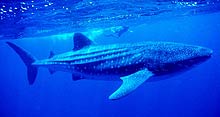Theme 1 - Sharks are an important part of marine ecosystems
Our current understanding suggests that the role of higher-level predators is important in
maintaining the marine ecosystem. All sharks are predators although some shark species are not at
the top of the food chain. Within the Australian species the whale shark and the megamouth shark
sit at one extreme with a large zooplankton component to their diet.
At the other extreme sit the
great white shark and the broadnose sevengill shark that feed on a range of invertebrates and
vertebrates, and include a high proportion of mammals in their diet.
Ideas for schools
Develop a food chain for different species of sharks. Include the other
species that make up the marine ecosystem and draw arrows that show how the energy flows from
one species to another. Also, see the relevant information sheet on the MESA Seaweek 2005 web site
compiled by Mike Bennett and Simon Pierce, with links to the schools-activities booklet.
|
|

Great white shark
Image © Ken Hoppen Photography

Whale-shark
Image © Ken Hoppen Photography
|
|
|
Theme 2 - There is a wide variety of different types of sharks,
and their relatives the rays and chimaeras, in Australia
The key feature that distinguishes Chondrichthyans - sharks, rays and chimaera - from the bony
fishes and other higher vertebrates (amphibians, reptiles, birds and mammals) is that their skeletons
are made of cartilage.
There are nearly 400 living species of shark, nearly 600 living species of ray,
and 33 living species of chimaera worldwide. Approximately 300 species of Chondrichthyans have been
discovered in Australian waters. More species are likely to be discovered as the deep ocean waters
are better explored.
Ideas for schools
Collect pictures of different sharks, rays and chimaeras from the Internet.
These could be used to make up a collage. Students could research a different species and present a
pictorial reportof their research on it. Also, see the relevant information sheets on the MESA Seaweek
2005 web site compiled by Terence Walker, with links to the schools-activities booklet.
|
